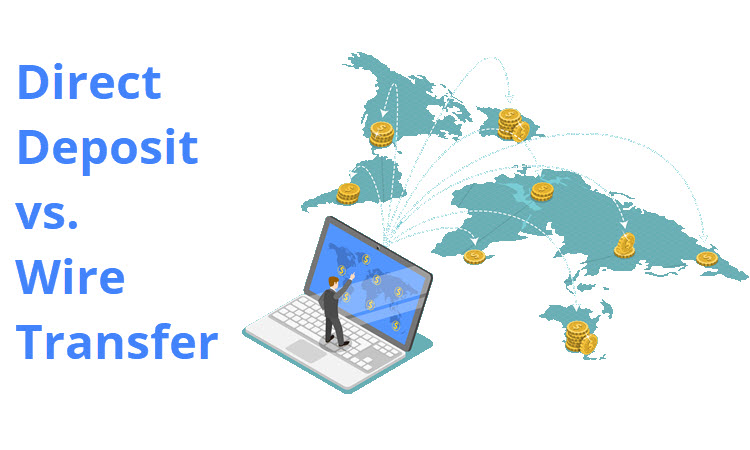Direct deposits are a type of ACH payments, commonly used by business organizations to make batch payments.
Wire transfers are direct bank-to-bank payments that are usually faster, but more expensive than direct deposits.
Each of these payment methods brings certain benefits, depending on the payers' needs and preferences. Let’s compare direct deposit vs. wire transfer to discuss their advantages and drawbacks.
Wire Transfer vs. Direct Deposit: Quick Overview
The table below lists all significant differences between wire transfer and direct deposit:
| Category |
Direct Deposit |
Wire Transfer |
| Geographical limitations |
US only |
Both US and international payments |
| Security & safety |
Supervised by the NACHA |
Mediated by the SWIFT and Fedwire protocols |
| Money transfer fees |
From 0.5% to 1.5% for business organizations |
$10 to $30 fee for transfers inside the US; higher fees for international transfers |
| Transaction speeds |
24 to 48 banking hours |
Up to 24 banking hours for US transfers; up to 48 banking hours for international payments |
| Common uses |
Used by organizations making batch and recurring payments (salaries, travel expenses, bonuses, expense reimbursements, tax refunds, as well as government and social security payments) |
International transactions dealing with higher amounts of money |
For additional comparison points, read the following sections.
Direct Deposit Explained
A direct deposit is an electronic money transfer from one bank account to another.
Every direct deposit transaction is carried out by a network of interconnected financial institutions called the Automated Clearing House (ACH). The supreme ACH body in the US is called the National Automated Clearing House Association (NACHA).
The recipient needs to provide the following data to the payer to receive assets through a direct deposit:
- Recipient’s bank account number.
- Bank name.
- Bank’s routing number.
When the payer receives the data above, they need to enter it into their bank account. After that, the assets are ready for transfer. They are deposited into the payee’s bank account at midnight on the due payment date.
Wire Transfer Explained
In a wire transfer, money is paid from one bank account number to another.
You need to follow these steps to successfully complete a wire transfer:
- The payer asks for a transfer from their bank.
- The payer’s bank sends a transfer notification to the recipient’s bank.
- The recipient’s bank gathers payment information from the payer’s bank.
- The bank sends its funds from the sender’s account to the recipient’s account.
- When the assets are paid to that account, the money is finally transferred to the recipient’s bank and the transaction between two banks is completed.
Fedwire and SWIFT are the two mediating payment companies that facilitate wire transfers. Moreover, there are hundreds of different financial institutions that together participate in wire transfers.
Note: It is possible to perform wire transfers without bank account numbers. For example, services such as Western Union wire transfer directly to individuals, without a bank account.
Wire Transfer and Direct Deposit: Detailed Comparison
Security and Safety
Direct deposit payments are monitored by the NACHA, which double-checks payment information and verifies the payment.
It’s possible to request a return of direct deposit funds in the following cases:
- The transferred amount of money was different from the authorized one.
- The transfer was launched earlier than agreed.
- The direct deposit transfer was made without authorization or the recipient changes the bank account in the meantime.
Wire transfers are mediated by the Fedwire and SWIFT payment network, which apply their special protocol to keep wire transfers safe from unauthorized access.
It’s not possible to get a return on wire transfers.
Costs and Fees
Business organizations making direct deposits usually pay certain fees. For instance, if a company is to pay salaries to its employees via direct deposits, the fee would typically range from 0.5% to 1.5% of the total paid amount.
Wire transfers usually cost between $10 to $30 per transaction inside the US.
International wire transfers usually cost more, because more banks are included in the payment process between the payer and the payee.
Transaction Speeds
Since the NACHA controls and verifies direct deposits, it usually takes from one to two banking days to complete direct deposit payments.
If sent before the bank cutoff time, money sent via a wire transfer inside the US is available to recipients within the same banking day.
For international wire transfers, 48 hours (two banking days) is a typical timeframe for money to be transferred from the sender’s to the recipient’s account.
Arranging a Transfer
Direct deposit consists of the following steps:
- The payee gives the payer their name, bank account number, and routing number.
- The payer (the originator) makes a payment file with the provided data.
- The payer’s bank (Originating Depository Financial Institution - ODFI) receives the payment file and sends it to the relevant ACH operator.
- The ACH operator sends the entry to the payee’s bank (Receiving Depository Financial Institution - RDFI).
- The payee (the receiver) receives the money from their RDFI.
If you want to make a wire transfer inside the US, log into your e-banking account or physically go to your bank, enter the recipient’s name, bank account number, and the amount of money to be paid.
For international wire transfers, the payer needs to provide the following information:
- Payee’s full name and address.
- Payee’s bank full name and its physical address.
- Payee’s bank account number and type (whether it’s a checking account, a savings account, or any other kind).
- Payee’s routing number.
- Payee’s SWIFT code (if necessary).
- Payee’s IBAN number (used by banks in most European countries).
- Purpose of the transaction.
- Payment amount.
Limitations
Direct deposits under the jurisdiction of the NACHA are limited to the territory of the US only, and to US dollars.
Wire transfers are equally appropriate for transfers made within the US, and for international payments.
Common Uses
Direct deposit payments are most commonly used by business organizations paying salaries to their employees. Other common uses include paying government and Social Security benefits, as well as tax reimbursements, travel expenses, and other payments made by companies or governmental bodies to citizens.
Wire transfers are typically used by organizations making payments to their international suppliers, customers, and employees.
Wire Transfer vs. Direct Deposit: Which One Is Better for You?
Companies should consider opting for direct deposit payments in the following cases:
-
Paying your staff inside the US. Direct deposit to a number of employees’ accounts is a convenient option, mostly because you’ll pay a fee on the entire amount of paid money. Also, such payments usually don’t have to be finished the same day, because you can make the batch salary payment two days before the salary date.
-
Making payments lower than $100,000 per day. NACHA limits same day direct deposits made by a single business entity to $100,000 a day. Banks may set their own limit, so check with your bank what their daily limit for direct deposits is. If your direct deposit payment doesn’t surpass that limit, go for it.
-
Ecommerce merchants accepting payments from their clients. Since direct deposit payments are monitored and verified by the NACHA, they can be reversed. For ecommerce sellers and buyers, this is a significant benefit that ensures a higher payment convenience.
Opt for wire transfers for:
-
International and immediate payments. Wire transfers are a more economical option when making international payments, and when you want payees to receive the money as soon as possible.
-
Transactions above $100,000. If a single payment goes beyond this threshold, wire transfers usually incur lower fees than direct deposit payments.
Conclusion
Both direct deposits and wire transfers are practical payment options, but for different purposes.
Take into account the pros and cons presented in the analysis above and use them to make the right decision when choosing the most suitable option for your payment needs.






